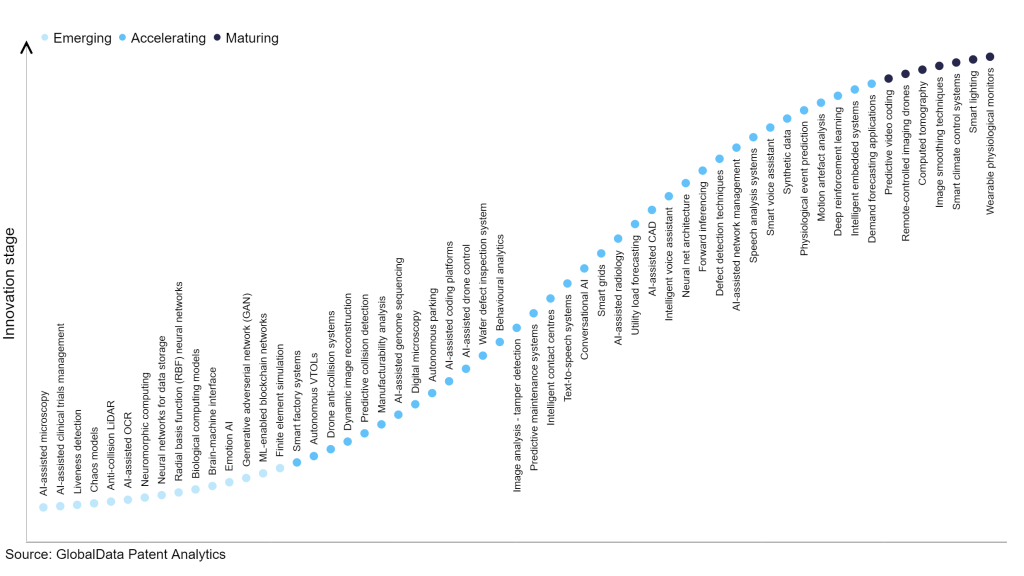The technology industry continues to be a hotbed of innovation, with activity driven by the rapid emergence and widespread adoption of game-changing technologies such as artificial intelligence (AI) and the advancements in natural language processing and machine learning technologies, enabling more sophisticated and accurate conversational interactions between humans and machines, improved customer engagement and efficient automation and scalability in customer services. Conversational AI may also use dialog management and knowledge graphs to control the flow of conversation and organise and represent structured information. In the last three years alone, there have been over 3.6 million patents filed and granted in the technology industry, according to GlobalData’s report on Innovation in Artificial Intelligence: Conversational AI. Buy the report here.
However, not all innovations are equal and nor do they follow a constant upward trend. Instead, their evolution takes the form of an S-shaped curve that reflects their typical lifecycle from early emergence to accelerating adoption, before finally stabilising and reaching maturity.
Identifying where a particular innovation is on this journey, especially those that are in the emerging and accelerating stages, is essential for understanding their current level of adoption and the likely future trajectory and impact they will have.
300+ innovations will shape the technology industry
According to GlobalData’s Technology Foresights, which plots the S-curve for the technology industry using innovation intensity models built on over 2.5 million patents, there are 300+ innovation areas that will shape the future of the industry.
Within the emerging innovation stage, finite element simulation, ML-enabled blockchain networks and generative adverserial network (GAN) are disruptive technologies that are in the early stages of application and should be tracked closely. Demand forecasting applications, intelligent embedded systems, and deep reinforcement learning are some of the accelerating innovation areas, where adoption has been steadily increasing. Among maturing innovation areas are wearable physiological monitors and smart lighting, which are now well established in the industry.
Innovation S-curve for artificial intelligence in the technology industry

Conversational AI is a key innovation area in artificial intelligence
Conversational AI refers to an AI system crafted to replicate human-like conversation, utilised for automated customer services, assisting in task fulfilment, and delivering information or recommendations to individuals.
GlobalData’s analysis also uncovers the companies at the forefront of each innovation area and assesses the potential reach and impact of their patenting activity across different applications and geographies. According to GlobalData, there are 340+ companies, spanning technology vendors, established technology companies, and up-and-coming start-ups engaged in the development and application of conversational AI.
Key players in conversational AI – a disruptive innovation in the technology industry
‘Application diversity’ measures the number of different applications identified for each relevant patent and broadly splits companies into either ‘niche’ or ‘diversified’ innovators.
‘Geographic reach’ refers to the number of different countries each relevant patent is registered in and reflects the breadth of geographic application intended, ranging from ‘global’ to ‘local’.
Patent volumes related to conversational AI
Source: GlobalData Patent Analytics
Alphabet is a leading patent filer in the conversational AI space. The company’s patents are aimed at inventing methods, systems, and apparatus, with computer programmes encoded on computer storage media for learning pronunciations from acoustic sequences. One method includes receiving an acoustic sequence, the acoustic sequence representing an utterance, and the acoustic sequence comprising a sequence of multiple frames of acoustic data at each of a plurality of time steps; stacking one or more frames of acoustic data to generate a sequence of modified frames of acoustic data.
The company also filed patents related to processing the sequence of modified frames of acoustic data through an acoustic modelling neural network comprising one or more recurrent neural network (RNN) layers and a final CTC output layer to generate a neural network output. Processing the sequence of modified frames of acoustic data involves subsampling modified frames of acoustic data and processing each subsampled modified frame of acoustic data through the acoustic modelling neural network. The other prominent patent filers in the space include Samsung Group and Apple.
By geographic reach, Saalex Information Technology leads the pack, followed by Valeo Comfort & Driving Assistance and Personics. In terms of application diversity, Walmart holds the top position, followed by Kip Prod P1 and Prodea Systems.
Conversational AI plays a significant role in revolutionising customer engagement by delivering personalised and efficient interactions, resulting in increased satisfaction and loyalty. Additionally, it empowers businesses to automate tasks, improve operational efficiency, and gain valuable insights from customer interactions, driving overall growth and success.
To further understand how artificial intelligence is disrupting the technology industry, access GlobalData’s latest thematic research report on Artificial Intelligence (AI) – Thematic Intelligence.
Data Insights
From

The gold standard of business intelligence.
Blending expert knowledge with cutting-edge technology, GlobalData’s unrivalled proprietary data will enable you to decode what’s happening in your market. You can make better informed decisions and gain a future-proof advantage over your competitors.







